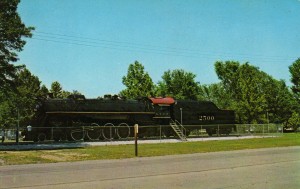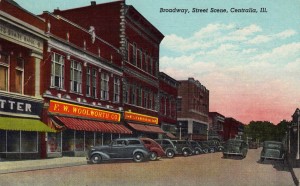
"Where two great highways cross!" declared a Vandalia brochure from the 1940s, referring to U.S. 40 and U.S. 51. The latter road is a north-south highway through the center of Illinois. When Illinois began to create a system of automobile roads in 1918, the road was State Bond Issue route 2. In northern Illinois, portions of the oldest alignment of 51 is still called IL 2. When federal highways began in 1926, highway 51 was one of the series of 1-ending north-south roads with U.S. 1 on the east coast and U.S. 101 on the west coast. Highway 51 itself begins at U.S. 2 at Hurley, Wisconsin, near Lake Superior, and ends at U.S. 61 at LaPlace, Louisiana, 1286 miles south. Originally, the road continued another 73 miles, concurrent with U.S. 61, into New Orleans.
Here are some interesting sites. This one features pictures of the highway as it crosses Illinois:
http://www.highwayexplorer.com/il_EndsPage.php?id=2051§ion=1 This site has shots of the old pavement before U.S. 51 was rerouted concurrently with Interstate 39:
http://www.roadsites.org/losthwy/us-051_wi.html Finally this one shows the southern end of 51 in Louisiana:
http://www.southeastroads.com/us-051_la.html
My childhood acquaintance with U.S. 51 included only about 95 miles: 65 miles to the north to Decatur, Illinois, and 30 miles to the south to Centralia, Illinois. Centralia has about 14,000 population in 2000, Decatur about 82,000, and my hometown Vandalia, 7000. Both communities were places my parents and I went to shop on occasion. I also got my teeth straightened by a Centralia orthodontist, so our drives down 51 to that office were frequent during my early teenage years. Naturally, the scenery in both directions became significant personal memories.

In fact, two of my very earliest memories relate to U.S. 51. One is a childhood visit to see a railroad engine on display at Centralia's Fairview Park. (See
http://www.ageofsteammemorial.org/) The visit must've been fairly soon after the engine was moved to the location in 1962, when I was five, but I'd never seen anything so massive and amazing!
The other early memory is a childhood visit to Kitchell Park in Pana, IL, thirty miles north of Vandalia. I think the occasion was a family reunion of some sort, but I don't remember which reunion. Our yearly Crawford family reunions happened in late August in Vandalia. I remember being upset when two bigger boys wouldn't let me play on a seesaw. To console me, my mother walked me over to a foot bridge, pictured in this very old postcard.

The bridge is still there. On a recent return trip, I was surprised to see how small it is compared to my childhood memories. When you grow up, things seem to shrink. The bridge, dated 1910, was about fifty years old at the time of our family reunion and now it's over 100. Sometimes, when I'm at the edge of a lake or stream, this old bridge appears in my memory. We used to live along a small lake and, as I mowed the lawn, the scene came to mind. The same thing happens when I see a Monet painting of water and water lilies.
I've lots of other childhood memories of U.S. 51. Ghost signs are advertisements painted on the side of buildings and other structures, but the signs are fading and not always legible. One of my favorites is gone: a Miller High Life logo painted on a silo beside the road, a few miles north of Vandalia. I went to high school with the girl who lived on that farm in the 1970s. I didn't pass by the place for several years but the last time I did, the logo had pretty much vanished.
Barns with advertisements painted on their roofs or sides are particularly interesting. A favorite book,
Rock City Barns, has pictures of two barns along U.S. 51 near Vandalia. The one I saw most often was several miles south of town. I say "was" because although the barn is still there (last time I passed by, anyway), the once-white letters on the roof had completely oxidized and were no longer recognizable.

Original U.S. highway signs (1920s and 1930) were cut-out shields with embossed letters and numbers, then after World War II, cut-out shields with flat letters were more common. In the 1960s and after, the cut-out shields were replaced by square, black signs with white shields and black numbers. During the late 1990s, when I took my father on a visit to Ramsey, IL so he could visit his grandparents' graves, I noticed one of those post-war shields on a side street, where (I assume) it was unnoticed when signs were replaced. It's gone now, sadly, but how fun to chance upon a relic of highway history.
Two-lane highways followed existing streets and roads. As we traveled to Decatur, I liked the zigzag but still northbound way that 51 passed through Pana: north on Poplar St., then east on First Street for five blocks, north on Cedar Street across the railroad tracks, east on Jackson Street for a mile or so, and then north toward Decatur. Read any guidebook for driving old Route 66 and you'll find similar, zigzag alignments through towns. (Before the widening of U.S. 51 reaches Pana, I need to give a shout-out to a highway curve north of that town, which I always loved.
It's just a gentle curve through the landscape, with a sign pointing east toward a place called Dollville.)
Driving south from Vandalia, I liked those river bottom lands which often flooded in rainy seasons... a little hill called Pole Cat Mound...a lumber mill near the road where a great-aunt and uncle of mine lived...the barn roof that advertised Rock City...the small slope with a bath tub (apparently a trough for

farm animals) nearby...a sign for a Lutheran Church located down the county road... a small and junky, crossroads antique store where I only visited once because the proprietor was so profane....a line of trees that indicated a much earlier alignment of the highway....a roadside picnic area, between the main road and another, earlier alignment.... Rural sight after rural sight along a gray two-lane road, accompanied by telephone poles and the tracks of the Illinois Central Railroad. The large petroleum storage tanks near the village of Patoka intrigued me as a little kid because there were so many of them, huge cylinders that had landed from the sky. A few once had the red Pegasus logo for Mobil.
 |
| Old fabric shop in Vernon |
Among those villages I mentioned earlier, I liked Vernon (population 178 in 2000), paradoxically, because of involuntary time spent there. My mother was at one point an interested sewer, and she loved the remnant and fabric shop in Vernon. I was a little boy and waited and waited and waited in the car for her to finish shopping; I read nearly all of
A Christmas Carol as I sat in the back seat. But I liked the town because it is so small, the houses are not close together, and you have the (to me) peaceful experience of seeing the farm fields and bordering timber beyond the village as you look from highway through three or four blocks the
village's yards. I also liked the simply little playground and the G.A.R. monument, an inauspicious park but, I'm sure, sufficient for a little kid living in the tiny place.
Driving to Centralia, you arrive in Central City, Illinois, which is continuous with Centralia, and you feel a little relieved to be in a town again as you pass florists, gas stations, small churches, and motels. There was once a discount store along northbound 51 where my mom liked to shop for picture frames, and where I liked to browse the bins of LPs. I remember purchasing the Moody Blues'
Question of Balance album there, and perhaps others.
(Speaking of music: what songs or pieces remind you of favorite roads? I've another blog post about that,
http://paulstroble.wordpress.com/2010/06/11/musical-roadtrips/, but Route 51 certainly brings to mind particular songs from high school years: Moody Blues' "Question" (with its epic opening), Mason Williams' "Classical Gas," The Hollies' "Long Cool Woman," Nilsson's "Without You," The Who's "Overture" [see below], ELO's "Fire on High" [with its backward lyric, "The music is reversible, but time is not. Turn back! Turn back! Turn back! Turn back!"], and others.)

Driving from the north, Central City soon merges into Centralia, and you arrive at Centralia's business district. My parents enjoyed shopping there, though less frequently than our monthly or bimonthly trips to St. Louis. Along Broadway, there were nice clothing stores (at one, I purchased some Cub Scout paraphernalia), a very cool newspaper office designed in Egyptian style, the store Centralia Stationary, which my mom particularly liked (it still operates), and a music store where I bought sheet music. I was thrilled to find the music for "The Overture from
Tommy," which I'd heard on the radio in the Assembled Multitude version rather than The Who's. Compared to my hometown's, Centralia's business district was not appreciably larger or more cosmopolitan (compared to Decatur's, for instance), but it seemed so to me, a little kid, as we strolled from the stores near the Illinois Central tracks on the west and the grand trees and stately library in Library Park to the east. Perhaps that pre-kindergarten visit to the railroad engine gave to me an extra bit of appreciation for the small town.
Another Centralia/U.S.51 memory: a childhood visit to the synagogue there, as a Vacation Bible School field trip. But I've acknowledged that shul's influence on my life in another blog post, concerning the Exodus and Christian Faith (
http://bibleconnections.wordpress.com/the-exodus-and-our-faith/).
A few years ago I discovered a German word,
fernweh, which means “far sickness.” It’s the opposite of “home sickness” but is a similar kind of longing: longing for a place that’s not home, a nostalgia for some place distant. I’ve experienced this feeling for places more exotic than our drives on U.S. 51, but the sights were enough like–and close enough to–my own home places that home- and far-sickness mingled. The sights along U.S. 51---the houses, churches, small industry, and business districts--were other people’s landscapes. In a childish way I wondered what people’s lives were like in these “distant” areas, creating in me the feelings described well by that word.
But there is also good old nostalgia, the pleasure of driving a two-lane road you've known your whole life. Wherever I drive, I like to play music---much of Ralph Vaughan Williams' music, some of Elgar's and Holst's, and others---that my brain has "placed" into home scenes like those along U.S. 51.








